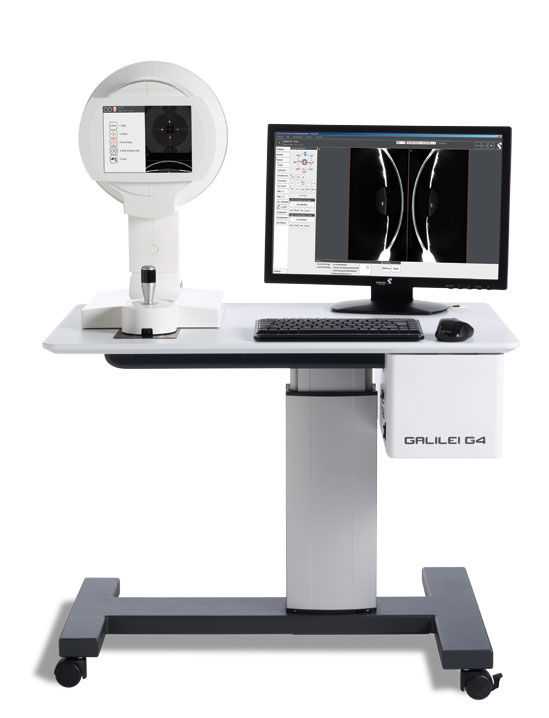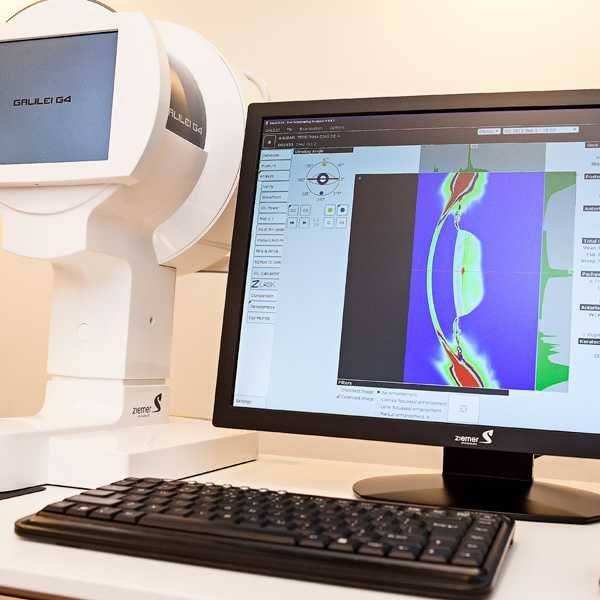ZIEMER Galilei G4 Topographer is an all-in-one solution that combines state of the art technology like optical biometry and Placido topography to allow practitioners to carry out effective and precise refractive and cataract surgery planning. ZIEMER Galilei G4 makes it possible for examiners to get all the necessary measurements all from one place.
The ZIEMER Galilei G4 Topographer is ideal for a variety of applications including refractive evaluation, cataract evaluation, and therapeutic evaluation.
G4 Key Features:
• High-Resolution Scheimpflug images
• Pachymetry
• Corneal and Lens topography
• 3D Anterior chamber analysis
• Crystalline Lens thickness
• Corneal and lens densitometry
• Pupillometry
Vital features of the G4
Some of the key features of the Galilei G4 include :
Placido Topography
With most of the corneal examinations, it is always important to get very accurate and precise data that relates to the anterior curvature of the cornea. Getting this measurement wrong will mean that the entire procedure or treatment may be in jeopardy because the examiner will be working blind. However, Galilei G4 has the ability to produce Placido topography which in turn delivers accurate and detailed curvature cornea data. With this instrument, examiners can precisely detect any kind of irregularity that may be present in the anterior surface as well as the quality of the tear film.
Dual-Scheimpflug Tomography
The process of detecting bulging of the cornea as well as problems with the asymmetry is now easy, thanks to the dual-scheimpflug tomography capabilities of the Galilei G4. It can be easily used for precise elevation of data as well as the precise pachymetry of both the posterior and anterior surfaces which will then be evaluated to give an indication if there is any bulging or to detect the onset of asymmetry. This is now easy because the system that the Galilei G4 uses has two Scheimpflug cameras, and these have helped to immensely reduce the amount of time needed to measure the anterior segment. This is not to mention the accuracy which it has also brought along the process.
1st Purkinje Alignment
The concept of 1st Purkinje reflex asserts that all data and maps should have the same reference point. In most of the times, this reflex has always been aligned to the visual axis leading to very accurate surface data as well as a great deal of consistency when it comes series comparisons of executive measurements over a given period of time. Without the correct 1st Purkinje alignment, it would be troublesome to locate the visual axis and this may lead to inaccurate surface data as well as lack of consistency in the alignment.
The work of G4 optical biometry is to help determine the measurement of the central corneal thickness, the axial length, the lens thickness, and the anterior chamber depth, all during the same examination. In the absence of the Galilei G4, all these measurements would require individual measuring, and this will not just introduce a variety of variations, but they may also be inaccurate, leading to wrong examinations and ultimately, the wrong type of lenses.
It is always the thickness of the measured length, as well as the precise measurement of both posterior and anterior corneal power that will be necessary for mapping out the next generation IOL planning.
Technical Specifications:
- Scheimpflug camera resolution – 2x1280x960
- Top view camera resolution – 1280×960
- Placido disc – 20 monochrome rings
- Number of measurement points – up to 100 000
- Displayed map coverage – 10mm
- Keratometry – 25-75D (4.5-13.5mm)
- Central corneal thickness – 250-800µm
- Keratometry in-vivo repeatability – +/- 0.1D
- Central corneal thickness in-vivo repeatability – +/- 2µm
The ZIEMER Galilei G4 applies an intelligent iris-pattern tracing system to correct for eye motion.
- New automatic surface alignment to correct for misaligned measurements
- Have confidence in your follow-up measurements thanks to the realignment of maps in 3-D
- Ideal to monitor corneal stability and changes in your patient’s eye

